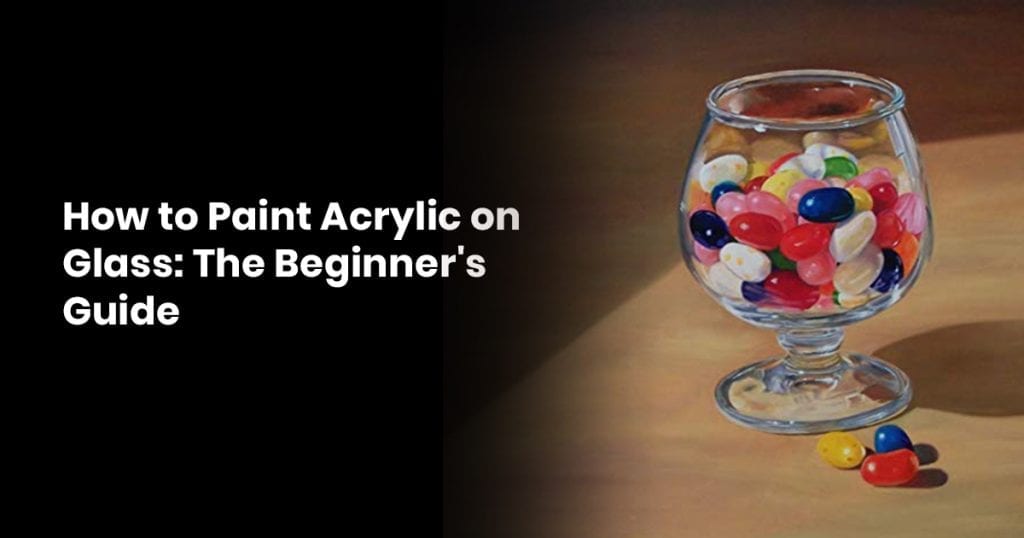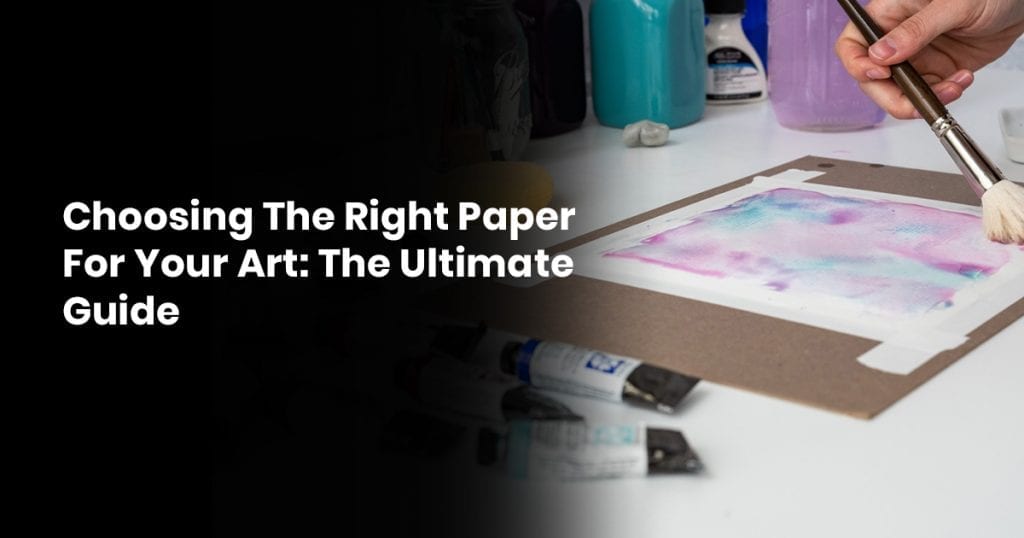Glass painting isn’t as hard as most people tend to think. In fact, not only is it easy for beginners but it’s fun.
So, whether you want to create some good-looking DIY home decoration or you are looking to expand your artistic repertoire, glass painting is definitely a skill worth learning.
With a bit of practice and guidance, you shouldn’t have trouble knowing how to paint glass, and this article is here to help you master this art.
With all the tips and tricks, you’ll find in this piece on the most common ways how to paint on glass windows, vases, jars, etc, you’ll get to glass painting in no time.
What Paints Should You Use on Glass?
Glass can hold up to the right paints incredibly well. However, without the right supplies, you won’t be able to get your desired results.
When it comes to the kind of paint you’ll need, there are several different options available. But, most of these options are have an acrylic base formula.
Contents
Acrylic Enamel Paint
This may sound like an oxymoron because enamel paint is oil-based and acrylic paint is water-based. However, it’s more like bringing the best of both worlds together. Acrylic enamel paint products bond a wide array of surfaces, including glass. The hard shell it forms on the surface helps make sure the colours stay in place.
Acrylic Glass Paint
This is a purely acrylic-based paint. But, it is slightly different from the conventional acrylic paints on the market, which do not adhere to glass’ smooth surface. Consider using acrylic paints that are specifically designed for tile or glass surfaces, since they contain chemical compounds that allow for the acrylic base of the paint to stick to non-porous surfaces.
Solvent-Based Paints
This is basically a fancy name for oil-based paints. These kinds of paints have incredibly high levels of organic matter that help stick to glass surfaces better than their water-based counterparts. You will get super saturated colours when you use solvent-based paints. However, you need to remember that these paint options are much harder to clean and way more toxic than their acrylic counterparts.
The kind of glass paints you’ll need to use will usually depend on many different things. For example, markers are good when you want fine detailing, but won’t be ideal for the kind of surface coverages you may want when it comes to glass painting on vases and jars.
On the other hand, solvent-based paint products can provide you with outstanding results. However, they are not ideal for those glass painting with children or somewhere where there isn’t great ventilation.
Spray Paint
There are very many different kinds of spray paint products suitable for glass painting. You can get these products in solid, metallic, stone, transparent and several other finishes. Just ensure you read the spray cans in several light coats. Typically, you can paint on top either with enamel or chalk paints if you want to make extra additions to your design.
Paint Markers and Pens
There are many different kinds of paints markers and pens available. A very popular one is Sharpie Oil-based. You can draw with these pens and markers just like you would with any regular pens and markers. There are not many specific instructions here.
What Kind of Glass Should you Use?
You can paint on any glass. However, you’ll need to have the proper paint for this. You can use latex paint products but those typically won’t give you the best coating. The most ideal product for painting on glass is acrylic enamel paint. Acrylic glass paints can also go onto any type of glass.
Glass Painting Ideas
Now that you have most of the basics down, it is time to think about what you want to paint on your glass. Below are a few glass painting ideas that can hopefully inspire you.
Painting on Wine Glasses
Why not make that set of boring wine glasses a little bit better. Consider turning them into your very own hand-painted masterpieces. Do this and you’re sure to have a hit at the next dinner party you hold.
Painting on Wine Bottles
And while we’re still on the subject of wine, why not go a step further and paint the empty wine bottles as well. Don’t toss these bottles out when you can recycle them. There’s a lot you can do with a glass-painted wine bottle once it has been transformed into a masterpiece.
Painting on Glass Windows
A bit of paint can help give a whole new light to the interior of a home. When it comes to painting on glass window panels, you’ll want to consider either using non-permanent paint products. However, you can also paint on standalone panels that won’t be hard to remove if you want the breathtaking looks of permanent paints.
Painting on Glass Ornaments
Glass painting on ornaments can be a great holiday activity. There are so many different glass painting techniques you can use with your whole family. Painting on glass ornaments is a good way to create fantastic gifts and one of the most ideal ways to make your own holiday decorations.
Painting on Glass Jars
There are numerous glass painting techniques that’ll help bring stunningly transparent looks to your glass jars. Painting glass jars will allow you to use these jars as decorative accents around the house, particularly when you want to display certain flowers and plants.
Painting on Glass Vases
Glass painting can help lend an ultra-original and ultra-special look to literally any glass vase. If you don’t have any lying around the house, why not visit the dollar store and pick from a wide selection of affordable glass vases to see what will best suit your needs.
Painting on Glass Coasters
Another great holiday gift idea is painting on glass coasters. You can also make your glass coaster a bit more original by putting your own design on them. You can even pair these with a great bottle of wine and give them as housewarming gifts. You can also just design a specific set that’ll match your coffee or dining table décor.
Painting on Glass Pendants
Lastly, why not consider creating unique glass jewellery by using glass paint to upgrade your previously understated glass pendants. This can be an endlessly customizable way of making your own glass jewellery at home. Furthermore, which such tiny surfaces, it is also a fantastic way to practice your detailing techniques.
How to Remove Paint From Glass
Whenever you’re doing DIY glass painting around the house, it’s always a good idea to have a contingency plan in case you get bored or you find you don’t like what you’ve painted.
The first thing you need to do when it comes to removing paint from glass is assess the damage. How much glass paint did you actually use in the process can help determine the level of cleanup you’re looking at.
Ideally, paint is meant to be removed while it’s still wet. However, if you want to remove the paint after it has already dried up then you can use the techniques below to help you get rid of what you put on your glass surfaces.
Method 1- Sharp Edges and Water
- Put a little soap in a bucket of warm water.
- Use this soapy warm water and sponge to cover the glass paint marks.
- Use a razor blade to scrape off the paint once it softens
- Hold the razor blade at a 45–50-degree angle and make sure not to scratch your glass surfaces.
- Scrape the paint off with smooth, slow movements.
- Once you’ve successfully removed the paint, use window cleaner to clean up the surfaces.
Method 2- Strong Solvents
For starters, you need to remember to avoid inhaling the solvent’s fumes. Ventilate the area you’re working in as much as possible.
You can use rubbing alcohol to dissolve acrylic paints and nail polish remover/acetone for enamel paints.
When using solvents;
- Put a bit of solvent on a cloth and use that to wipe the paint off your glass surfaces
- You might have to make several applications.
Method 3- Heat
Sometimes you can use the heat from a hot air gun or hair dryer to soften the paint on your glass so you can scrape it off. But, this comes with some risk factors. You can easily crack the glass surface if you apply the heat to suddenly.
How do you Remove Spray Paint from Glass?
It can be hard to remove spray paint from glass surfaces. The best way to do this will depend on the kind of glass surface you’re working with and the kind of paint you used.
Before you start to remove the spray paint from your glass surfaces, take a little time in the beginning just to prepare for the process ahead. Consider the kind of glass surfaces you’ll be working with and then gather the necessary supplies.
When dealing with potent solvents, always remember to ventilate the space you’re using and make sure you’re using the right safety equipment like eye protection and rubber gloves.
Method 1- Acetone
Acetone is perfect for getting rid of spray paint from glass surfaces. Acetone products such as nail polish remove, lacquer thinner and paint thinner can help you remove spray paint from glass surfaces.
Get a cloth and soak it in acetone. Wipe down the dried paint and leave the acetone on for a couple of minutes. Once the stain starts to loosen, use the acetone-soaked cloth again to scrub the paint off.
Get another clean rag, preferably a microfiber cleaning rag, soak it in warm water and then use it to clean off the excess acetone solution. Dry the surface using a dry cloth or paper towel once you’re through.
Method 2- White Vinegar
If you don’t want to use chemicals, consider using white vinegar instead. White vinegar is often used on metal surfaces but it works great on glass surfaces too.
The acid in white vinegar can dissolve paint stains. You can also use it to clean your paintbrushes and is safe for fibreglass surfaces, as well.
Heat up the vinegar in the microwave using a microwave-safe or Pyrex measuring cup. Use oven mitts or gloves to avoid getting burnt when removing it from the microwave. Once out, get a clean cloth and soak it in the hot vinegar.
Use this vinegar-soaked rag to loosen the dried paint. You’ll need to press the rag on the paint for a couple of minutes for this to happen.
Method 3- Rubbing Alcohol
Rubbing alcohol is a great way to remove spray paint from glass surfaces. The concentrated rubbing alcohol recommended is around 70% but 90% is usually better.
Get a clean cloth and soak it in the rubbing alcohol and then use this rag to loosen the dried paint. Once the paint is a bit loose, dip the rag in alcohol and use it again to get rid of the paint.
Denatured alcohol is a great paint stripper as well. It’s a lot stronger than concentrated rubbing alcohol, so be extremely careful with it.
What’s Back-Painted Glass?
Back-painted glass is a form of clear glass that’s painted from the back and viewed from the front end. Back-painted glass is usually used in colored glass walls/screens for interior glazing, architectural spandrel glass, artistic glass, colored glass backsplashes, marine glass, shower walls, etc.
You can use back-painted glass options as a modern-day alternative to other different surfacing materials like laminates and tiles.
Final Takeaway
Reflective and smooth glass can make for a great glass painting canvas. However, if you haven’t painted on glass before, you’ll need to acquaint yourself with a few of the basics because painting on glass is a lot different from painting on the other more traditional and conventional surfaces.
With that said, as a beginner, you can still achieve those satisfying and remarkable results with a little guidance and practice.
Hopefully, this article can be that guide.




